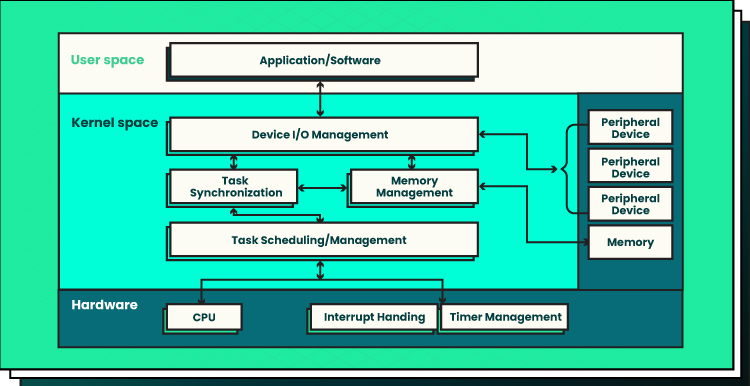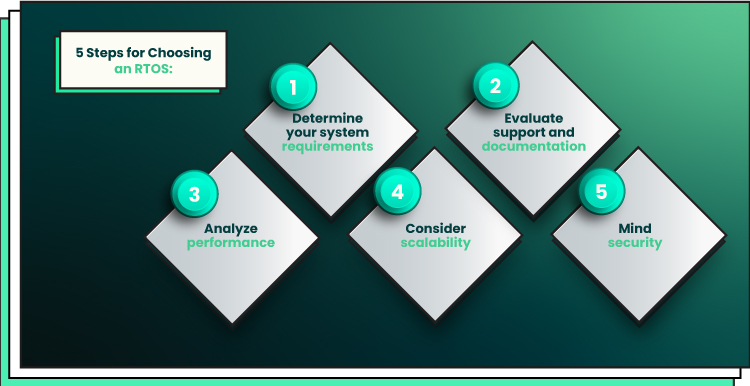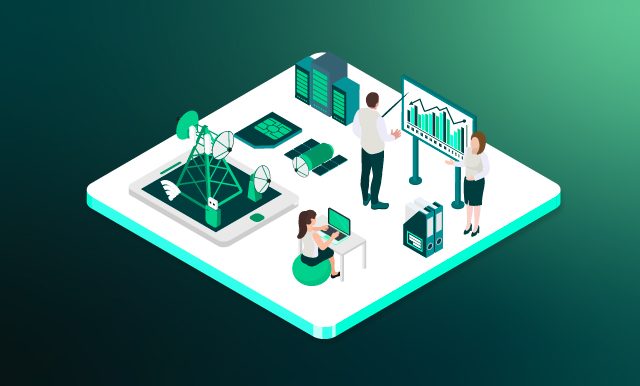A real time operating system (RTOS) is a type of computer software that helps manage the time it takes for tasks to be completed. It’s designed to ensure that essential processes are finished quickly and efficiently, so you can get things done faster.
Let’s dig into more details.
OS vs. RTOS
An operating system (OS) and a real-time operating system (RTOS) are two different types of software programs that are used to control the general operations of a computer or other electronic devices. While both serve the same basic purpose, they differ in their capabilities and design.
An OS is a software program that acts as the interface between the user and the underlying hardware of a computer or electronic device. It is responsible for controlling the overall operation of the computer or device, including managing memory, loading and running applications, and controlling input/output (I/O) devices like keyboards, displays, and other accessories. In addition, an OS also provides basic functions such as file management, networking, and security.
An RTOS, on the other hand, is specifically designed for real-time applications. It is a specialized type of OS that provides quick and reliable responses to input signals, allowing applications to respond quickly and accurately to external events. RTOSs are often used in applications that require a rapid response to events, such as in industrial automation, embedded systems, and automotive systems.

How do OS and RTOS differ?
- The main difference between an OS and an RTOS is how they respond to input signals. While an OS can take a few milliseconds to respond to input signals, an RTOS can respond in a fraction of a millisecond, allowing applications to react to external events quickly and accurately. In addition, an RTOS can also handle multiple tasks in parallel, while an OS can only handle one at a time.
- Another critical difference between an OS and an RTOS is the amount of customization they offer. An OS is designed to work with a range of hardware and software, while an RTOS is designed to work with specific hardware and software. This means an OS can be easily modified to support different hardware or software configurations, while an RTOS is limited to a certain set of hardware and software.
- Finally, an OS is commonly used in computers and other electronic devices. In contrast, an RTOS is often used in embedded systems, such as industrial automation, automotive systems, and other specialized applications.
An OS and an RTOS both provide the same basic functions, but they differ in terms of speed, control, and multitasking capabilities. An OS can be tailored to the user’s needs, while an RTOS is better suited for applications that require quick response times and the ability to run multiple processes simultaneously.
How Does A Real Time Operating System Works?
RTOS is created to provide a predictable response time to external events by controlling the order in which tasks are executed. The tasks are scheduled in a queue, and each task is given a priority level.
To understand how a real-time operating system works, it’s important to understand the basic components that make up the system.
1. RTOS will include a kernel, which is the core of the system.
The kernel handles all operations the operating system must perform, such as scheduling tasks, managing memory, and handling interrupts. The kernel also provides the interface to the hardware, allowing the operating system to interact with the system’s components.
2. RTOS will include a scheduler.
The scheduler is responsible for assigning tasks to the CPU so that the system can ensure that tasks are completed within the specified time frame. The scheduler will also manage the resources of the system, such as memory so that the system can prioritize certain tasks over others.
3. RTOS will include a set of drivers and libraries.
These are used for communicating with the hardware, such as the processor, memory, and other peripherals. This allows the operating system to access and control the hardware to complete its tasks.
Here’s the classic architecture of an RTOS:

Another essential feature of an RTOS is the ability to handle interrupts. Interrupts are external events that occur during the execution of a task, such as a user input, that require immediate attention. The RTOS handles these interrupts and can suspend the current task, if necessary, to handle the interrupt. This ensures that all tasks are given the attention they need and that the system is not overloaded with too many tasks.
RTOSes are subdivided into soft and hard real-time systems.
- A soft RTOS is often used in applications that require responsiveness but don’t demand the highest levels of accuracy. Examples include interactive multimedia applications, video conferencing, and home entertainment systems.
- A hard RTOS, on the other hand, is designed for applications that require the highest levels of accuracy and reliability. Examples include industrial control systems, factory automation systems, and medical equipment.
Why Use RTOS?
Real-time operating systems are increasingly becoming an integral part of many embedded systems and technology products. By leveraging the power of RTOS, developers can be confident that their application’s architecture will be reliable and able to meet the most demanding requirements.
Here are some of the benefits of using an RTOS.
Priority-Based Scheduling
Tasks can be organized in order of importance, ensuring they are processed efficiently and quickly. This helps improve system responsiveness, as more important tasks are given priority over less essential ones. Additionally, this scheduling ensures no task will ever remain unfinished due to a lack of resources or memory. As a result, your processes can run smoothly without any delays or interruptions. Furthermore, with priority-based scheduling, companies have better control over which tasks get done first, making it easier for you to manage complex operations.
Abstracting Timing Information
RTOS can separate the processes from their individual run times, allowing you to easily view and analyze them without worrying about potential delays or bottlenecks in the system. As a result, it becomes much easier for developers to debug complex systems quickly and efficiently as they can pinpoint errors without manually calculating time-related parameters. Furthermore, abstracting timing information also helps make applications more robust as they are less likely to be affected by fluctuations in processing power or workloads.
Maintainability/Extensibility
RTOS can prioritize certain processes while avoiding time lags or system overloads due to a lack of resources or memory. This allows users to have complete confidence in the performance of their applications, ensuring that all tasks are completed on time without any interruptions.
Modularity
The task-based API of RTOS encourages modular development, meaning that applications can be broken down into individual tasks. This makes each task easier to develop and maintain. With an RTOS, you can easily customize it to meet your specific needs by adding or removing features and components as needed. This makes it easier to upgrade and maintain the solution since only the necessary parts are installed.
Team Development
The task-based system of RTOS also allows designers/teams to work independently on their project parts. This encourages collaboration and increases productivity. It also promotes teamwork by allowing multiple people to work on different parts of the project simultaneously. With an RTOS, tasks can be split between several team members while still being managed in real time. This allows projects to be completed faster and more efficiently than if they were handled manually. Additionally, since this kind of system is designed to handle many tasks at once, it can often provide better multitasking capabilities compared to other operating systems.
Easier Testing
Modular task-based development leads to modular task-based testing. This makes it easier to test applications and identify any potential bugs in the code. A major advantage of using an RTOS is that it makes testing easier. Unlike traditional operating systems, it can be tested on different devices and platforms in real-time, so you know exactly how they will perform when released to the public. With an RTOS, developers have access to powerful tools that make identifying and fixing errors much faster than with other operating systems. This makes them more reliable and efficient in the long run.
Code Reuse
With RTOS, similar applications on similar platforms will often lead to the development of a library of standard tasks. This means developers can use existing code, such as device drivers, for new projects instead of writing everything from scratch. This saves time and money by allowing developers to focus on the more important aspects of a project instead of spending hours rewriting code.
Characteristics of a Real-Time Operating System
RTOS has become increasingly important in the modern world. From controlling robotics to managing critical systems, it’s the backbone of many complex machines.
To meet the stringent requirements for these types of applications, the systems have their distinct characteristics:
- Small footprint: compared to other operating systems, real-time operating systems are lightweight and have a small memory footprint. This is to ensure that they can operate on low-power, low-cost hardware and still maintain high performance.
- High performance: RTOSs are designed to offer fast and responsive operation. This is essential for applications where precise timing and accuracy are of the utmost importance.
- Determinism: real-time operating systems are designed to offer repeatable results. This means that when an input is repeated, the same output is expected.
- Safety and security: safety and security are two of the highest priorities for RTOSes. These systems are frequently used in critical applications and must adhere to strict standards to maintain the highest level of safety and security.
5 Steps for Choosing an RTOS
When choosing an RTOS, there are several factors to consider that will help you make the right decision.

1. Determine Your System Requirements
Consider the amount of available memory, the type of processor, and the application-specific requirements. These requirements will help you narrow down your choices and decide which RTOS will best meet your needs.
2. Evaluate Support and Documentation
Look for up-to-date documentation and tutorials to help you quickly get up and running. Also, check for any additional services that may be offered, such as support chats, bug tracking, and customer support.
3. Analyze Performance
Evaluate the features and performance of the RTOS to determine how it will handle the tasks required by your application. Make sure the RTOS can meet the performance requirements of your application and that the RTOS has the necessary tools to measure performance.
4. Consider Scalability
Make sure that the RTOS you choose can scale up or down as needed. This will ensure that your application can utilize the latest technology and remain compatible with existing systems.
5. Security
Security is always a top priority for any system. An RTOS should be designed with security in mind and offer a range of security measures to protect your system. Look for an RTOS that offers built-in protection against malicious software and other threats.
By taking the time to consider these factors, you can ensure that you choose the right RTOS for your project. With the right RTOS, your application will have the performance, scalability, and security it needs to be successful.
Final Word
Real-time operating systems are essential for many applications requiring timely responses to events or tasks. From medical equipment to industrial automation and even mission-critical aerospace applications, RTOSes are used in many applications.
If you need help with your current operating system, contact us, and we’ll gladly provide you with any assistance you may require. Forbytes is an expert at building new digital products and improving business strategies.

Our Engineers
Can Help
Are you ready to discover all benefits of running a business in the digital era?

Our Engineers
Can Help
Are you ready to discover all benefits of running a business in the digital era?







